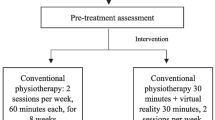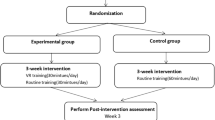Abstract
Stroke has been one of the leading causes of death worldwide for the past 15 years. Upper limb dysfunction is one of the main symptoms in stroke patients. The purpose of is to evaluate the treatment effectiveness of Immersive virtual reality system in upper limb rehabilitation. A single-blind clinical trial, and pretest–posttest control group design trial was conducted. The Fugl-Meyer Assessment of Physical Performance, Box and Block Test of Manual Dexterity, and FIM self-care score were used at baseline and post intervention. All subjects were asked to complete a total of twenty training sessions over eight weeks. The results of this project can be summarized as follows: (1) A total of eighteen stroke patients were involved in the trial, 15 males and 3 females, with an average age of 57.42 years (SD 12.75), and time from stroke (Mean 8.78 months, SD 5.51). (2) Results of the differences between the two groups pretest–posttest showed that the two groups were significantly differences in FMA (Conventional group, p = 0.021; Immersive virtual reality group, p = 0.014). It is known from the above results that the immersive virtual reality game device contributes to the improvement of the functions of the upper limbs. The results of this project are expected to provide a reference for innovative design in the medical industry and the entertainment industry.
Access this chapter
Tax calculation will be finalised at checkout
Purchases are for personal use only
Similar content being viewed by others
References
Hatem, S.M., et al.: Rehabilitation of motor function after stroke: a multiple systematic review focused on techniques to stimulate upper extremity recovery. Front. Hum. Neurosci. (2016). https://doi.org/10.3389/fnhum.2016.00442
Global Health Estimates 2016: Deaths by Cause, Age, Sex, by Country and by Region, 2000–2016. Geneva, World Health Organization (2018)
Ministry of Health and Welfare: Statistics on the cause of death of Taiwan in 2018. https://www.mohw.gov.tw/cp-16-48057-1.html. Accessed 20 Oct 2019
McCrea, P.H., Eng, J.J., Hodgson, A.J.: Biomechanics of reachin: clinical implications for individuals with acquired brain injury. Disabil. Rehabil. 24, 534–541 (2002)
Baldominos, A., Saez, Y., Pozo, C.G.: An approach to physical rehabilitation using state-of-the-art virtual reality and motion tracking technologies. Procedia Comput. Sci. 64, 10–16 (2015)
Rose, T., Nam, C.S., Chen, K.B.: Immersion of virtual reality for rehabilitation – review. Appl. Ergonom. 69, 153–161 (2018)
Huygelier, H., Schraepen, B., Ee, R., Abeele, V.V., Gillebert, C.R.: Acceptance of immersive headmounted virtual reality in older adults. Sci. Rep. 9, 4519 (2019)
Gagliardi, C., et al.: Immersive virtual reality to improve walking abilities in cerebral palsy: a pilot study. Ann. Biomed. Eng. 46(9), 1376–1384 (2018)
Lee, S.H., Jung, H.Y., Yun, S.J., Oh, B.M., Seo, H.G.: Upper extremity rehabilitation using fully immersive virtual reality games with a head mount display: a feasibility study. The Journal of Injury, Function and Rehabilitation (2019). https://doi.org/10.1002/pmrj.12206
Marsha Bisschop, A.G., et al.: Immersive virtual reality improves movement patterns in patients after ACL reconstruction: implications for enhanced criteria-based return-to-sport rehabilitation. Knee Surg. Sports Traumatol. Arthroscopy 24(7), 2280–2286 (2016)
Jareda, A., Brianb, C., Justinc, D.: Immersive virtual reality in traumatic brain injury rehabilitation: a literature review. Neuro Rehabilit. 42(4), 441–448 (2018)
HTC Vive. https://www.vive.com/us/experiences/. Accessed 21 Nov 2019
Sanford, J., Moreland, J., Swanson, L.R., Stratford, P., Gowiand, C.: Reliability of the fugl-meyer assessment for testing motor performance in patients following stroke. Phys. Ther. 73(7), 447–454 (1993)
Wilson, R.: Box and Block Test of Manual Dexterity (2002). http://healthsciences.qmuc.ac.uk/labweb/Equipment/Box%20and%20Block%20test.htm. Accessed 27 Dec 2010
Ravaud, J.F., Delcey, M., Yelnik, A.: Construct validity of the functional independent measure (FIM): questioning the unidimensionality of the scale and the “value” of FIM scores. Scand. J. Rehabil. Med. 31(1), 31–41 (1999)
Cohen, J.: Statistical power analysis. Curr. Direct. Psychol. Sci. 1, 98–101 (1992)
Baldominos, A., Saez, Y., Pozo, C.G.: An approach to physical rehabilitation using state-of-the-art virtual reality and motion tracking technologies. Procedia. Comput. Sci. 64, 10–16 (2015)
Acknowledgment
This study was partly supported by the Ministry of Science and Technology (No. MOST 107-2221-E-040-006), the Fujian Provincial Social Science Planning Project (A study on the usage and design suggestions of upper limb rehabilitation products in Fujian and Taiwan hospitals with grant No. FJ2018B150), and Chung Shan Medical University (CSH-2020-A-039).
Author information
Authors and Affiliations
Corresponding author
Editor information
Editors and Affiliations
Rights and permissions
Copyright information
© 2020 Springer Nature Switzerland AG
About this paper
Cite this paper
Huang, LL., Chen, MH. (2020). Effectiveness of the Immersive Virtual Reality in Upper Extremity Rehabilitation. In: Rau, PL. (eds) Cross-Cultural Design. Applications in Health, Learning, Communication, and Creativity. HCII 2020. Lecture Notes in Computer Science(), vol 12193. Springer, Cham. https://doi.org/10.1007/978-3-030-49913-6_8
Download citation
DOI: https://doi.org/10.1007/978-3-030-49913-6_8
Published:
Publisher Name: Springer, Cham
Print ISBN: 978-3-030-49912-9
Online ISBN: 978-3-030-49913-6
eBook Packages: Computer ScienceComputer Science (R0)




